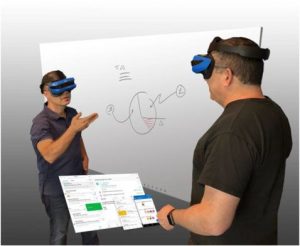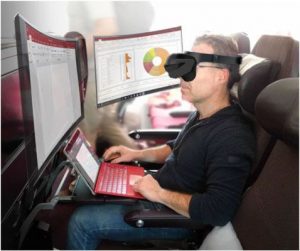The Office of the Future: Virtual, Portable, and Global
- Jens Grubert ,
- Eyal Ofek ,
- Michel Pahud ,
- Per Ola Kristensson
IEEE Computer Graphics & Applications | , Vol 38(6): pp. 125-133
Virtual reality has the potential to change the way we work. We envision the future office worker to be able to work productively everywhere solely using portable standard input devices and immersive head-mounted displays. Virtual reality has the potential to enable this, by allowing users to create working environments of their choice and by relieving them from physical world limitations, such as constrained space or noisy environments. In this paper, we investigate opportunities and challenges for realizing this vision and discuss implications from recent findings of text entry in virtual reality as a core office task.


Published by IEEE
Enhancing mobile work and productivity with virtual reality
As people work from home, new opportunities and challenges arise around mobile office work. On one hand, people may have flexible work hours and may not need to deal with traffic or long commutes. On the other hand, they may need to work at makeshift spaces, with less-than-optimal working conditions while physically separated from co-workers. Virtual reality (VR) has the potential to change the way we work, whether from home or at the office, and help address some of these new challenges. We envision the future office worker to be able to work productively everywhere, solely using portable standard input devices and immersive head-mounted displays. VR has the potential to enable this by allowing users to create working environments of their choice and by relieving…
Text Entry in Immersive HMDisplay-based VR using Physical and Touch Keyboards
We study the performance and user experience of two popular mainstream text entry devices, desktop keyboards, and touchscreen keyboards, for use in Virtual Reality (VR) applications. We discuss the limitations arising from limited visual feedback and examine the efficacy of different use strategies. We analyze a total of 24 hours of typing data in VR from 24 participants and find that novice users are able to retain about 60% of their typing speed on a desktop keyboard and about 40–45% of their typing speed on a touchscreen keyboard. We also find no significant learning effects, indicating that users can transfer their typing skills fast into VR. Besides investigating baseline performances, we study the position in which keyboards and hands are rendered in space. We find that…
Effects of Hand Representations for Type in VR
In IEEE VR 2018 Alphanumeric text entry is a challenge for Virtual Reality (VR) applications. VR enables new capabilities, impossible in the real world, such as an unobstructed view of the keyboard, without occlusion by the user’s physical hands. Several hand representations have been proposed for typing in VR on standard physical keyboards. However, to date, these hand representations have not been compared regarding their performance and effects on presence for VR text entry. Our work addresses this gap by comparing existing hand representations with minimalistic fingertip visualization. We study the effects of four hand representations (no hand representation, inverse kinematic model, fingertip visualization using spheres and video inlay) on typing in VR using a standard physical keyboard with 24 participants. We found that the fingertip visualization…
